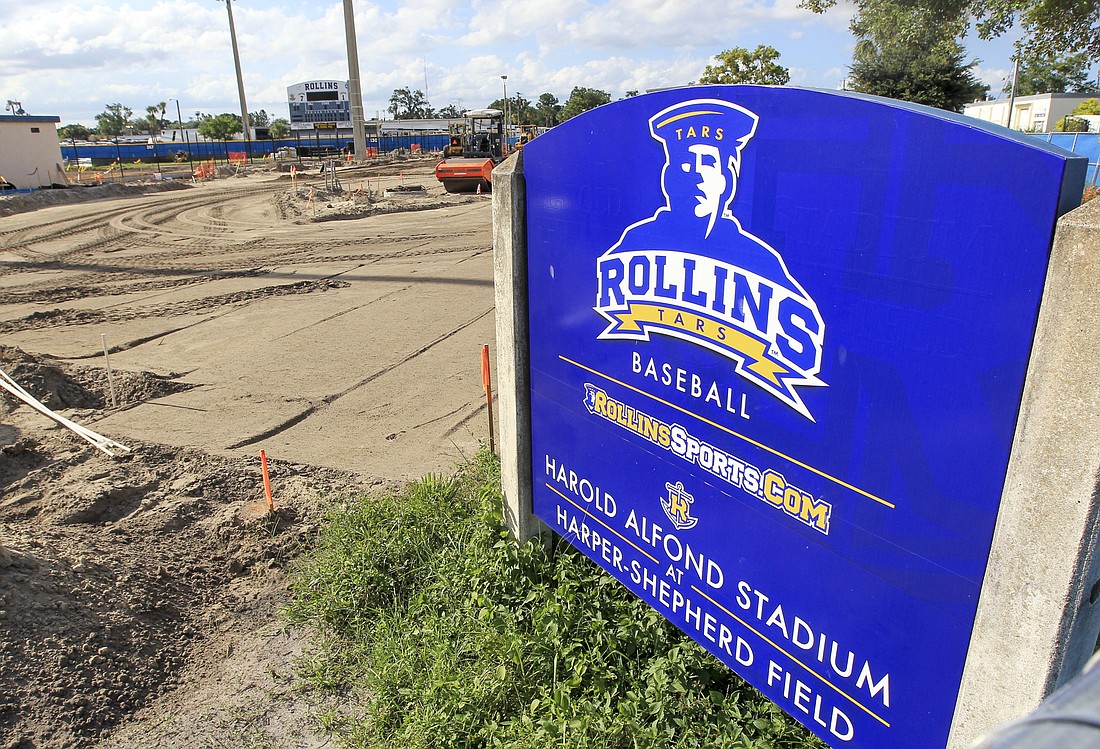- April 4, 2025
-
-
Loading

If you have driven by Alfond Stadium — which sits on the corner of Aragon and Orange avenues — then you likely have noticed the sounds of construction coming from behind the bright blue tarps.
You can’t see it, but since early June, the home of Rollins baseball has been getting a facelift in a few different ways. The Tars will be getting a new synthetic turf infield, safety netting around the field and a new locker room for the junior-varsity team, among other improvements.
The upgrades have folks such as Tars’ head coach Jon Sjogren chomping at the bit for next baseball season.
“As a baseball program, we are really excited about it,” Sjogren said. “The playing surface is going to be brand new, and it’s going to be field turf. We’re getting an upgrade in our bullpens and batting cages — it’s going to be real good for our kids and real good for our coaches.”
Alfond Stadium — located just one mile from the Rollins’ campus — has been a part of the Tars program dating back to 1933, when the college first bought the property from the city of Winter Park.
Although there have been upgrades throughout the facility’s 85-year history — including the renovation of the clubhouse in 1983 and lighting installed in 2012 — this newest collection of renovations is the biggest the stadium has seen in a while.
The biggest addition is the turf infield, said Scott Bitikofer, Rollins’ assistant vice president of facilities.
“The biggest thing is playability,” Bitikofer said. “We have two different programs in JV and varsity that play on that field, so therefore, there is a lot more traffic on the infield. By going to a synthetic surface, it allows us to get more playability out of the facility.
“And quite honestly the field is rather old, and over time as you work the infield clay … you keep adding, adding, adding, so the infield starts getting higher than the outfield and so it really needs to be stripped so it can be leveled,” he said.
The new infield will be much easier to maintain, and it will also offer something that has the coaching staff and facilities services staff excited — easier cleanup after storms.
Weather — especially in Florida — can lead to long delays as grounds crews try to get the infield dry. But with synthetic turf, the process is much simpler, Bitikofer said. Unlike clay and natural grass, the new turf won’t have an issue with water build-up.
The maintenance will be much simpler, but how about playability for the players who actually put the field to use?
The way the ball rolls and moves on field turf is much different than on natural grass and clay, which is always a concern for players not use to playing on turf. But according to Sjogren, the biggest challenge didn’t have anything to do with those folks on the field.
“When we played, we always played on natural surfaces, but the difference is all these kids grew up playing in all of these big tournaments up-and-down the East Coast where they’ve been on field turf all of their lives,” Sjogren said. “It’s not an adjustment for them; it was more of an adjustment for us (coaches).”
Sjogren and his staff also are looking forward to the new covered batting cages — which will be perfect for getting in batting and pitching practices in regardless of the weather. The new facilities will feature three covered cages, as well as a regulation mound and home plate.
All the updates are expected to be completed this fall, and Bitikofer plans to have the field in playing shape by the time the fall baseball season comes. Next summer, a second phase of renovations will include improvements to the stadium and clubhouse.
“When we take on a project like this for baseball, our goal is to make sure our baseball program has the facilities it needs to be successful,” Bitikofer said. “We want, first and foremost, our students to be safe, and we want them to be successful.”